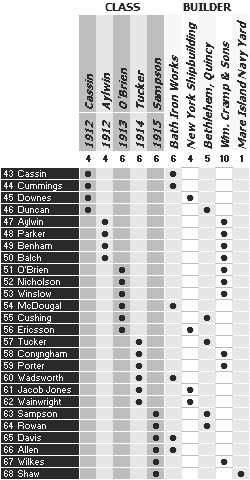

Four of the five active destroyer builders continued in the program: Bath Iron Works, Fore River, William Cramp & Sons and New York Shipbuilding. Commissioned between August 1913 and January 1917 with Shaw from California’s Mare Island Navy Yard added in April, the 1,000-tonners were the United States’ newest destroyers when it declared war on Germany on 6 April 1917.
They were also the first US Navy warships to arrive in the war zone: on 4 May, a division of six ships stood into Queenstown (Cobh), Ireland, where it joined British destroyers, trawlers, yachts and other craft in anti-submarine patrols and convoy and rescue operations. Other divisions arrived within the next few weeks. Together, they operated initially in the western approaches to Great Britain; later from a base at Brest, France. It was in this service that Jacob Jones became the only US destroyer lost to U-boat attack during the war.
Post-war, the 1,000-tonners were decommissioned and placed in reserve. Beginning in 1924, however, the Coast Guard borrowed twelve ships for operation as cutters: Cassin (CG-1), Conyngham (CG-2), Cummings (CG-3), Downes (CG-4), Ericsson (CG-5), McDougal (CG-6), Porter (CG-7), Davis (CG-21), Shaw (CG-22), Tucker (CG-23), Wainwright (CG-24) and Wilkes (CG-25). All were returned to the Navy in 1931–4.
In 1933, Aylwin, Balch, Cassin, Conyngham, Cummings, Cushing, Downes, McDougal, Perkins, Porter, Shaw, Tucker and Winslow lost their names in anticipation of new construction. Between 1934 and 1936, all the 1,000-tonners were sold and scrapped except one, Allen, which was retained with the flush deckers held in reserve at Philadelphia and recommissioned in 1940. After operating from Pearl Harbor through World War II, she was sold for scrap in 1946.